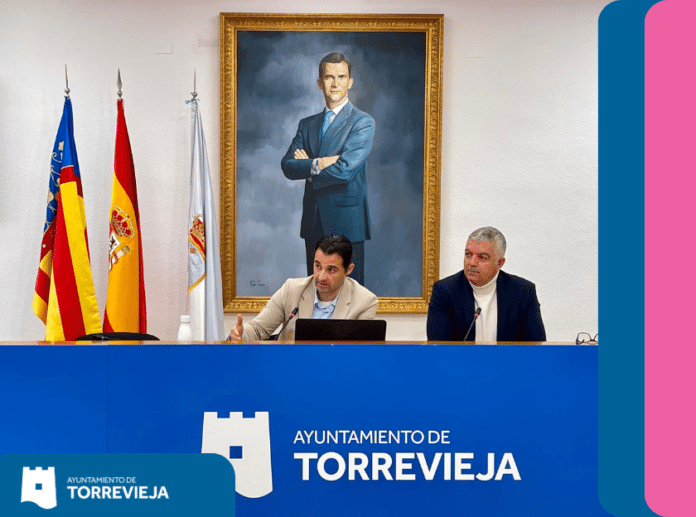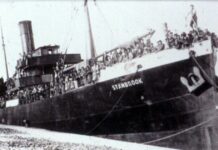The mayor of Torrevieja, Eduardo Dolón, and the Councillor for Transport, Antonio Vidal, presented the Torrevieja Urban Transport model, a service that has additional financing from the Next Generation Funds of the European Union, for an amount of 3,4 million euro. Likewise, the Service Project together with the Feasibility Study justify a concession duration of 15 years, with the cost of bidding for the service being 7,5 million.
This new urban transport service will have new line routes, new services and new frequencies. Construction of the fixed infrastructure necessary to provide these services, such as bus storage garages, bus maintenance and repair workshops, and user information offices.
In addition, the construction, improvement and maintenance, as well as the operation, of the different stops that make up the urban transport service are planned, improving them and carrying out the construction of some new ones.
Digitization of the service, providing an Operation Assistance System (SAE) that allows providing information to the user in real time, as well as optimising routes and determining possible incidents that the service may present.
As well as the acquisition of new hybrid and electric buses, which will considerably improve the comfort and safety of the vehicles, and will considerably reduce the GHGs (greenhouse gases) generated in the city.
THE SERVICE WILL HAVE 9 DAY AND 3 NIGHT LINES
The mayor has reported that the lines will increase, considering a total of 9 daytime lines and 3 nighttime lines, which will provide the service centralised in 3 interchanges. These are located on calle Ramón Gallud, in the parking lot of the Torrevieja Hospital and on calle Francisco Atienza, next to the Carrefour shopping centre.
From these interchanges, four types of lines are designed:
Circulars, which link interchanges 1 and 3 mentioned above, feeding the main infrastructures of the urban centre of Torrevieja: health centres, schools and institutes, sports areas, market area and urban centre.
Shuttles. This line is planned as a shuttle to the Torrevieja hospital from the urban centre, so that it will feed the entire southern area of Torrevieja and the cemetery.
Radial lines. These lines leave from one of the three interchanges, linking the circular lines and the shuttle with the most peripheral urbanisations of Torrevieja and with La Mata.
Nocturnal. They are lines that feed, from the most peripheral areas of Torrevieja and leaving the different interchanges, both to the nightclub area of the Industrial Estate and to the port area. These lines will only provide service, initially, on weekends throughout the year and during high season periods.
Circular Line
Circular Line. It has a route of 13.37 km. It is a circular route, in one direction, that runs through the centre of Torrevieja and connects the following demand points:
Eras de la Sal/Port of Torrevieja.
Habaneras/Carrefour shopping centre.
Bus station.
Sports areas.
Market area.
CEIP Acequión, Cuba, Salvador Ruso, Virgen del Carmen, Habaneras and Inmaculada.
Patricio Pérez, La Loma and Acequión health centres.
IES Mare Nostrum, Mediterráneo and Las Lagunas.
Total travel time = 47 min
Weekday passing frequency = 15.73 min
Line 1. Hospital
This line has a route of 9.76 km. It is a linear route in both directions, acting as a shuttle from the urban centre to the Torrevieja Hospital.
Demand points:
Port.
Torrevieja Hospital.
Acequión Health Centre.
Torrevieja Cemetery (on request).
Total travel time = 34 min
Weekday passing frequency = 11.49 min
Line 2. Los Altos-Rocío del Mar
This line has a length of 9.72 km, with a linear route in both directions. It runs through the urbanisations of Los Altos and Rocío del Mar, starting at the Torrevieja Hospital.
Demand points:
Torrevieja Hospital.
CEIP Romualdo Ballester
Cala Piteras.
Total travel time = 34 min
Weekday passing frequency = 17.15 min
Line 3. Los Balcones
The length of this line is 7.76 km, being a linear line in both directions, running in the residential area of the Los Balcones urbanisation.
The fundamental demand point that it feeds is the Torrevieja Hospital.
Total travel time = 27 min
Weekday passing frequency = 13.69 min
Line 4. Torretas
This line, like the previous ones, is linear in both directions. It has a length of 15.4 km.
Feeds the following demand points:
Port and Eras de la Sal.
Habaneras-Carrefour Shopping Centre.
Bus station.
CEIP Cultures and Immaculate Conception.
La Siesta Health Centre.
IES Torrevigía.
Total travel time = 54 min
Weekday passing frequency = 18.13 min
Line 5. San Luis
This line, like the others that feed the peripheral urbanisations of the city, is linear round trip. It has a length of 19.37 km, and feeds the following demand points:
Port-Eras de la Sal.
Habaneras-Carrefour Shopping Centre.
CEIP Immaculate.
IES Torrevigia.
San Luis Health Centre.
Total travel time = 68 min
Weekday passing frequency = 22.79 min
Line 6. Torreblanca – La Mata – Hospital Quirón
This line is also linear in both directions, having a length of 22.95 km. Feeds the following demand points:
Port-Eras de la Sal.
Quiron Hospital.
International Auditorium and Conservatory (on request).
CEIP Ciudad del Mar, Nuestra Señora del Rosario and Salvador Ruso.
La Loma, Patricio Pérez and La Mata Health Centres.
Sport’s zone.
Market Precinct.
IES Mare Nostrum, Las Lagunas and Libertas.
Total travel time = 81 min
Frequency of passage weekday = 20.25 min
Line 7. La Mata by Interior
This 17.5 km line will connect Torrevieja and La Mata through the interior avenues of Torrevieja. It is a line in both directions, joining the following demand points:
Port-Eras de la Sal.
La Mata.
CEIP Virgen del Mar, Virgen del Carmen and Inmaculada.
La Mata Health Centre.
IES Mediterráneo and Ciudad del Mar.
Total travel time = 62 min
Frequency of passing weekday = 20.60 min
Line 8. La Mata – Beaches
This linear route has a length of 20.27 km, and connects the following demand points:
Port-Eras de la Sal.
La Mata.
Beaches in the north of the municipality.
Health Centres of La Mata and Patricio Pérez.
Bus station.
Total travel time = 72 min
Weekday passing frequency = 17.88 min
Night Line
They will be provided every Saturday of the year, as well as daily in medium and high seasons, from 0:00 a.m. to 4:00 a.m.
Line N1. La Mata.
Total travel time = 51 min
Frequency of passage weekday = 60 min
Line N2. North.
Total travel time = 51 min
Frequency of passage weekday = 60 min
Line N3. South.
Total travel time = 57 min
Frequency of passage weekday = 60 min
Infrastructures. Stops
Types of stops designed:
Type 0. These are the interchanges and the stop on Calle Mayor de La Mata. The canopy will have a self-cleaning toilet integrated. The detail is similar to type 2 stops, but with the toilet.
Type 1. These stops consist of two shelters, an infobus and a series of urban elements that allow accessibility for users as well as a living area, and include the redevelopment of the entire area around the stop itself. This stop has been implemented at those stops where many lines converge or have a lot of user demand.
Type 2. It is similar to the previous one, but with a single canopy. It also consists of an infobus and urban elements of accessibility and stay. It also includes the redevelopment of the stop area. It has been implemented in those stops located in the urban area (Torrevieja and La Mata) that are not type 1.
Type 3. These stops consist of a shelter and infobus, but do not include urban works or elements except those strictly necessary to provide them with accessibility. These types of stops have been defined in urbanization areas where it is possible or necessary to have a shelter due to user demand.
Type 4. These stops consist only of an infobus, and a bench-type element to allow users to seat. It does not include a canopy, as its implementation is not possible, and it does not include redevelopment or urban elements except those strictly necessary to make the stop accessible. This type of stop has been provided in urbanization areas with little demand and where it is not possible to install a shelter.
SERVICE RATES (1)
Types of rates to be collected in the Regulatory Fiscal Ordinance:
Ordinary ticket. It is a single ticket, valid for one trip on Torrevieja’s urban transport. Its price is €1.35.
Multi-trip bus voucher. It is a fare included in a card or digital element, which can be recharged with a certain number of trips, usually 10 or 20. Its price is €9, for 10 trips, or €18 for 20 trips, that is, the price of the trip will be €0.90.
Special multi-trip bus voucher. It is a similar rate to the previous one, but where the price of the trip is €0.65. This rate is usable by those people who are in the following situations:
Young people under 26 years of age.
Large families.
Long-term unemployed (that is, more than 2 years).
GOLD Bonus. Users of this card have free trips on Torrevieja’s urban transport throughout the year, unlimitedly. They are usable for the following users:
People over 65 years of age registered in Torrevieja for more than 1 year.
Pensioners or people with a degree of disability greater than 33% registered in Torrevieja for more than 1 year.
SERVICE RATES (2)
Types of rates to be collected in the Regulatory Fiscal Ordinance:
Bonus 30. This rate is valid for all users. It is a flat rate that allows unlimited trips on urban transport for 30 days on all lines. Its cost is €38.
Tourist Card. It is a rate created primarily for tourists and people passing through. It allows unlimited use of urban transport lines during the stipulated time. There are two modalities:
3 days, with a cost of €8.
7 days, with a cost of €16.
MOBILE AND PERSONAL EQUIPMENT
The vehicles to be used in the service will be a total, considering the lines considered, of 32 units, of which 3 will be reserve and reinforcement. Of the 32 units, 25 units of hybrid operation and 7 units of completely electric operation are contemplated. The Council will transfer the use of these vehicles to the commercial concessionaire during the entire period of service provision, as they are supplied.
Fixed infrastructures to be built
Garages, workshops and information office on a municipal plot, shown in the plans of this project, which will be adjacent to the future intermodal transport station and a park and ride.
The room that serves as a garage must have capacity for the 32 urban buses that will provide the urban transport service in Torrevieja.
The area planned for the garage and workshop infrastructure amounts to 5,000 m², without taking into account the urbanised perimeter part, which amounts to another 1,500 m².
Improvement in the accessibility of stops. This action is included in this project and will be part of the specifications that will govern the service. It consists of eliminating stops that will no longer be used, enabling new planned stops, and improving existing stops, enforcing current accessibility regulations at all of them.
Estimation of deadlines
Approval of Cost Structure and referral to the Generalitat Valenciana Advisory Board
January 2024
PCAP and PPTP approval and SARA contract tender
April 2024
Tender calculation and successful bidder proposal
September 2024
Start-up of the service
December 2024





